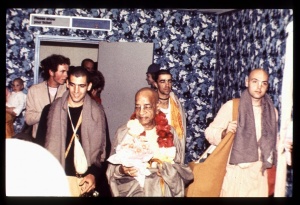CC Madhya 10.108 (1975)

A.C. Bhaktivedanta Swami Prabhupada
TEXT 108
- sannyāsa karilā śikhā-sūtra-tyāga-rūpa
- yoga-paṭṭa nā nila, nāma haila 'svarūpa'
SYNONYMS
sannyāsa karilā—accepted the sannyāsa order; śikhā—tuft of hair; sūtra—sacred thread; tyāga—giving up; rūpa—in the form of; yoga-paṭṭa—saffron-colored dress; nā nila—did not accept; nāma—name; haila—was; svarūpa—Svarūpa.
TRANSLATION
Upon accepting sannyāsa, Puruṣottama Ācārya followed the regulative principles by giving up his tuft of hair and sacred thread, but he did not accept the saffron-colored dress. Also, he did not accept a sannyāsī title but remained as a naiṣṭhika-brahmacārī.
PURPORT
There are regulative principles governing the renounced order. One has to perform eight kinds of śrāddha. One must offer oblations to one's forefathers and perform the sacrifice of virajā-homa Then one must cut off the tuft of hair called a śikhā and also give up the sacred thread. These are preliminary processes in the acceptance of sannyāsa, and Svarūpa Dāmodara accepted all these. However, Puruṣottama Ācārya did not accept the saffron color, a sannyāsī name or a daṇḍa, and for this reason he retained his brahmacārī name. Actually Puruṣottama Ācārya did not accept the sannyāsa order formally, but he renounced worldly life. He did not want to be disturbed by the formality of the sannyāsa order. He simply wanted to worship Lord Śrī Kṛṣṇa without disturbance; therefore with heart and soul he took up the renounced order but not the formalities accompanying it. Renunciation means not doing anything but serving the Supreme Personality of Godhead, Śrī Kṛṣṇa. When one acts on this platform, trying to please the Supreme Personality of Godhead, one is both a sannyāsī and a yogī. This is confirmed in the Bhagavad-gītā (6.1):
- śrī-bhagavān uvāca
- anāśritaḥ karma-phalaṁ
- kāryaṁ karma karoti yaḥ
- sa sannyāsī ca yogī ca
- na niragnir na cākriyaḥ
"The Supreme Personality of Godhead said: One who is unattached to the fruits of his work and who works as he is obligated is in the renounced order of life, and he is the true mystic, not he who lights no fire and performs no work."